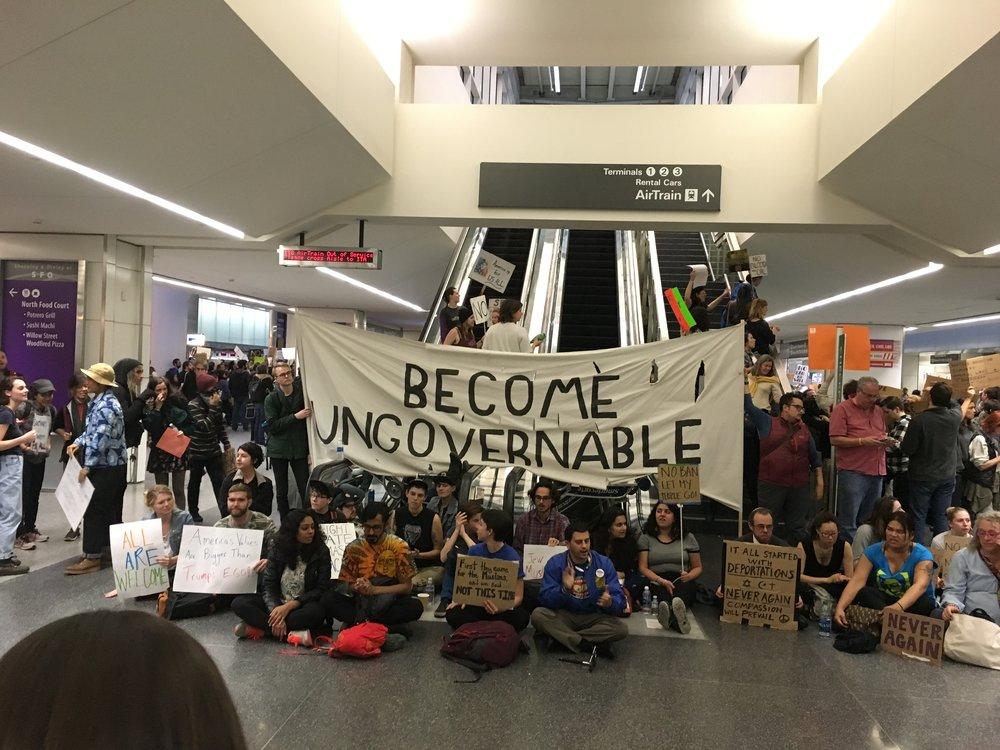Amid opposition, Trump moves forward with campaign promises
February 14, 2017
 Protesters in opposition to Trump’s immigration executive order demonstrate in the San Francisco International Airport.
Protesters in opposition to Trump’s immigration executive order demonstrate in the San Francisco International Airport.
In June 2015, Donald Trump spoke in the lobby of his New York tower and told a crowd of supporters and reporters that he intended to “build a great, great wall on our southern border.”
These first remarks created an uproar from activist groups in addition to a growing group of supporters who saw Trump as a representative for a disenfranchised group of Americans. In the weeks preceding his January inauguration, many critics and reporters believed that he would scale back what he called for during the campaign. These beliefs were not without precedent, as in his first televised interview with 60 Minutes a week after his election victory, he said the wall could be “part fence” and shifted the focus of deportations to undocumented immigrants who have been arrested.
Within his first two weeks in the oval office, Donald Trump has worked to address the promises he made to rally his core supporters. On inauguration day, he signed along with approving several cabinet nominations, an executive order that created a national day to celebrate patriotism that will take place on Sept. 11. This was symptomatic of celebrating the nationalism that was a significant driving force behind his campaign. Less than two weeks after his inauguration, he made steps to make his immigration platform a reality. This move has mobilized progressive groups to organize rallies to defend the rights of undocumented immigrants that they view as at risk of deportation. The limitations on his proposed wall are not only ideological. The building of a physical barrier on the southern border of the United States poses building and financial challenges. In a 2009 report conducted by the U.S government, it was told that to build one mile of our current fence it cost the government between 2.8 and 3.9 million dollars. Donald Trump has denounced the extent of our current fence so it would be assumed that the building of his project would come at a higher price. In February of last year on the day of the New Hampshire primary, Trump told Tamron Hall on MSNBC that he could complete the project at the cost of 8 billion dollars. News agencies have since reported that the construction of the wall would conservatively cost over 20 billion dollars, without accounting for money allotted for maintenance. The current Customs and Border Protection budget for 2017 is 13.9 billion, meaning the project would cost more than the amount of money the government currently has invested in border protection.
On Friday, Jan. 27, the focus of protests and opposition to the president shifted when President Trump issued an executive order stopping travel to the United States from seven majority Muslim countries: Iran, Iraq, Libya, Somalia, Sudan, Syria, and Yemen. The travel ban on the seven countries listed above is planned to last 90 days. Additionally, the executive order blocks all refugees from entering the country from anywhere for 120 days. The ban on refugees from Syria, however, is indefinite. Within the first 24 hours of the order, over 100 travelers were detained at the airports they arrived at and were not allowed to enter the country through customs. In the first hours, it was unclear to airport workers if this ban applied to workers with a green card. The order was amended within the weekend to allow for people to enter with this status. Although this order was more subtle than the ban on Muslims that was announced during his campaign for the Republican nomination, the countries the ban applies to are all majority Muslim. In an effort to defend his actions, Trump said that although he has sympathy for refugees, his primary “priority will always be to protect and preserve our country.”
Sophomore Aidan Loftis said that he “thinks the ban is a step towards protecting America” and does “not think it is based on religion or race.”
Opposition protests that erupted at airports where people were detained were based on the belief that the ban was based on religion and fueled by xenophobia. Protests that occurred at San Francisco International Airport were attended by hundreds of protesters including the California Lt. Gov. Gavin Newsom.








































